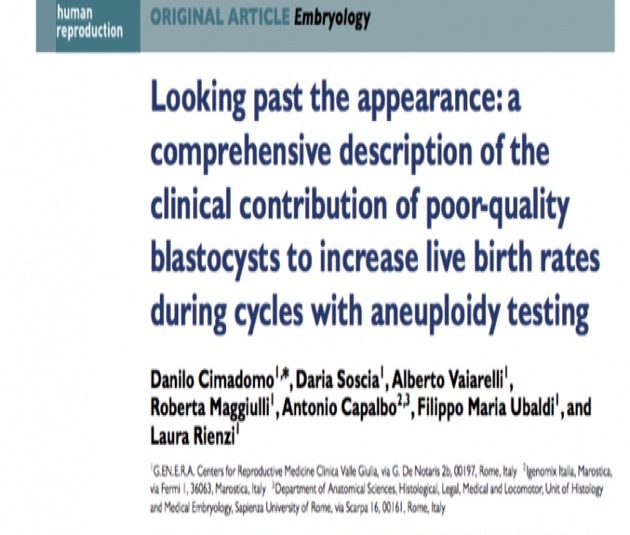
Danilo Cimadomo, Daria Soscia, Alberto Vaiarelli, Roberta Maggiulli, Antonio Capalbo, Filippo Maria Ubaldi, and Laura Rienzi
Human Reproduction, Volume 34, Issue 7, 2019 July 8, Pages 1206–1214, https://doi.org/10.1093/humrep/dez078
Abstract
STUDY QUESTION: Which are the clinical benefits and risks of including poor-quality blastocysts (PQBs) in the cohort of biopsied embryos during a cycle with preimplantation genetic testing for aneuploidies (PGT-A)?
SUMMARY ANSWER: PQBs show a worse prognosis with respect to sibling non-PQBs, but their clinical use allows an overall 2.6% increase in the number of live births (LBs) achievable after PGT-A.
WHAT IS KNOWN ALREADY: PQBs (<BB according to Gardner and Schoolcraft’s classification) are generally disregarded for clinical use and/or research purposes. Therefore, limited data exist in literature to estimate the benefits and risks deriving from the transfer of a PQB. In Italy, the law imposes the transfer or cryopreservation of all embryos, unless proven not viable. This regulation has allowed the production of a large amount of data regarding poor-quality embryos. Previous reports outlined a lower chance of euploidy and implantation for PQBs. Yet, a comprehensive picture of their real clinical contribution is missing.
STUDY DESIGN, SIZE, DURATION: This observational cohort study including 2757 oocyte retrievals for PGT-A (mean maternal age, 39.6±3.3 years) conducted at a private IVF centre between April 2013 and May 2018. A total of 1497 PQBs were obtained and their embryological, chromosomal and clinical features were compared to 5250 non-PQBs (≥BB according to Gardner and Schoolcraft’s classification) and adjusted for all significant confounders. After defining the overall increase in LBs due to PQBs, we outlined the population of patients who might benefit the most from their clinical use.
PARTICIPANTS/MATERIALS, SETTING, METHODS: ICSI cycles, involving ovarian stimulation, blastocyst culture, trophectoderm biopsy, vitrification, comprehensive chromosome testing and vitrified-warmed euploid single embryo transfers (SETs), were conducted. Overall analyses and sub-analyses in populations of patients clustered according to maternal age at retrieval and size of the cohort of sibling non-PQBs were performed. Finally, the risk of miscarriage and the chance of LB per biopsied PQB and non-PQB were estimated.
MAIN RESULTS AND THE ROLE OF CHANCE: PQBs allowed a 12.4% increase in the cycles where ≥1 blastocyst was biopsied. To date, we report a concurrent 2.6% increase in the cycles resulting in ≥1 LB. On average 0.7 ± 0.9 (range, 0–9) PQBs were obtained per cycle for biopsy, including 0.2 ± 0.4 (range, 0–5) euploid PQBs. Maternal age solely correlates with the prevalence of PQBs from both overall and cycle-based analyses. Indeed, the patients who benefit the most from these embryos (i.e. 18 women achieving their only LBs thanks to PQBs) cluster among women older than 42 years and/or those with no or few sibling non-PQBs (1.1 ± 1.1; range, 0–3). The 1497 PQBs compared to the 5250 non-PQBs showed slower development (Day 5, 10.1% versus 43.9%; Day 6, 60.5% versus 50.8%; Day 7, 29.4% versus 5.2%)
